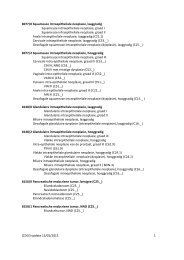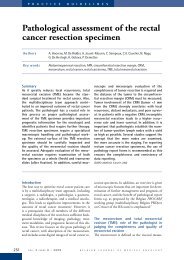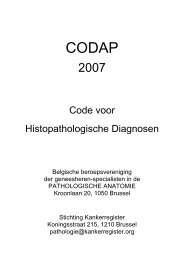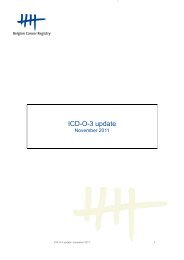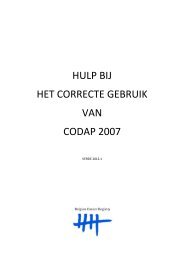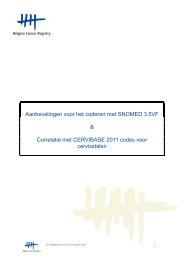Assurance de qualité pour le cancer rectal – phase 2 ...
Assurance de qualité pour le cancer rectal – phase 2 ...
Assurance de qualité pour le cancer rectal – phase 2 ...
You also want an ePaper? Increase the reach of your titles
YUMPU automatically turns print PDFs into web optimized ePapers that Google loves.
KCE Reports 81 PROCARE <strong>–</strong> <strong>phase</strong> 2 35Proportion of patients in whom a TRUS and pelvic CT and/or pelvicMRI was performed before any treatmentDEFINITIONNumerator: all patients with RC that un<strong>de</strong>rwent treatment and had a TRUS and pelvicCT and/or MRI before treatment.Denominator: all patients with RC that un<strong>de</strong>rwent treatment.Exclusion:• patients that didn’t receive treatmentRESULTSThirty-four percent of RC patients un<strong>de</strong>rgoing treatment received a TRUS and pelvicCT/MRI in the PROCARE cohort (Tab<strong>le</strong> 23). Of the 1067 patients receiving treatment,8 patients had no data on pre-treatment imaging (1%).The pre-treatment TRUS and pelvic CT/MRI is measurab<strong>le</strong> for 56 centres using theprospective database. E<strong>le</strong>ven centres have a score above 50%, whi<strong>le</strong> 10 centres score0%. Of these 10 centres, 7 centres inclu<strong>de</strong>d <strong>le</strong>ss than 5 eligib<strong>le</strong> patients. Seventeen and24 centres have a score above the weighted (34%; 95%CI 31 <strong>–</strong> 37%) and unweightedmean (28%; 95%CI 22 <strong>–</strong> 35%) respectively. Risk-adjustment (tumour localisation [low <strong>–</strong>mid <strong>–</strong> upper], tumour stenosis) is necessary for the correct interpretation of theseresults.In the administrative cohort, this QI is not measurab<strong>le</strong> due to an absence of a specificco<strong>de</strong> for pelvic CT and MRI.Tab<strong>le</strong> 23. Number of patients in whom a TRUS and pelvic CT and/or pelvicMRI was performed before any treatment, measured with prospectivePROCARE data.NPatients with <strong>rectal</strong> <strong>cancer</strong> 1071Patients with <strong>rectal</strong> <strong>cancer</strong> that received treatment (<strong>de</strong>nominator) 1067Patients in whom a TRUS and pelvic CT/MRI was performed before any treatment 366 (34%)(numerator)Proportion of patients with cStage II-III RC that have a reportedcCRMDEFINITIONNumerator: all patients with cStage II-III RC that un<strong>de</strong>rwent surgery and that have areported cCRM.Denominator: all patients with cStage II-III RC that un<strong>de</strong>rwent surgery.Exclusion:• patients with cStage other than II and III• cStage II and III patients not treated with surgeryRESULTSOf the patients with cStage II-III that un<strong>de</strong>rwent surgery, 26% have a reported cCRM inthe PROCARE cohort (Tab<strong>le</strong> 24). For 330 patients the cStage was unknown (totalmissings: 330/1071, 31%). Again, unavailability of the cCRM in the PROCARE registrydoes not always mean that the measurement was not carried out.The reported cCRM is measurab<strong>le</strong> for 51 centres using the prospective database. Twocentres have a score of 100%, whi<strong>le</strong> 27 centres have a score of 0%. Twelve and 14centres have a score above the weighted (26%; 95%CI 22 <strong>–</strong> 30%) and unweighted mean(19%; 95%CI 11 <strong>–</strong> 28%) respectively.The QI is not measurab<strong>le</strong> for the administrative cohort, since no administrative co<strong>de</strong>exists for the (documentation of the) cCRM.



